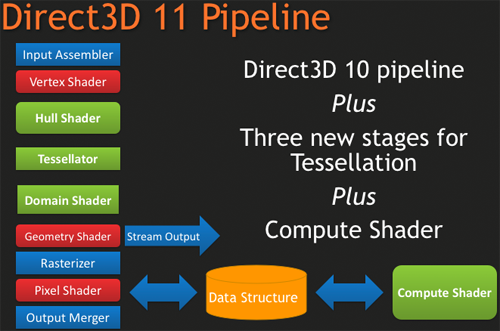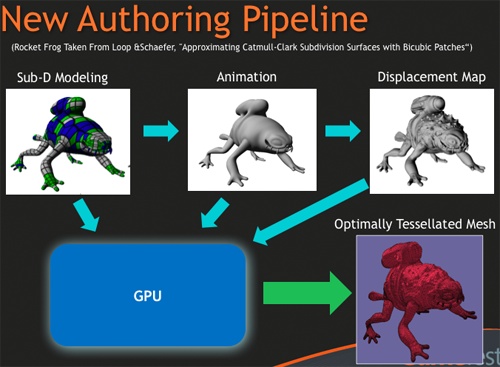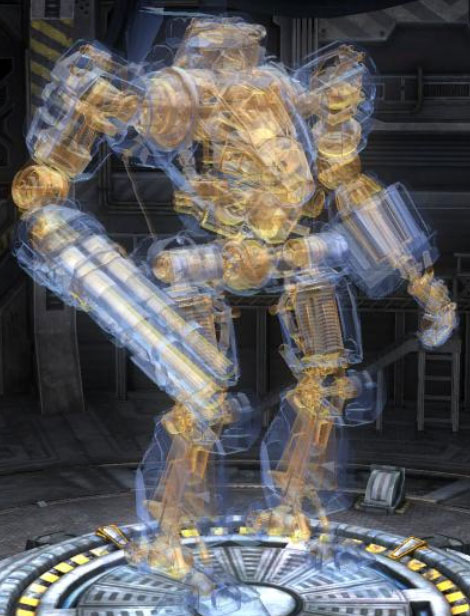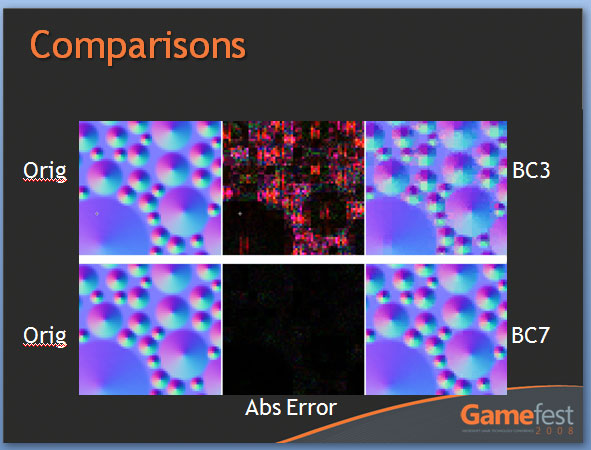AMD's Radeon HD 5870: Bringing About the Next Generation Of GPUs
by Ryan Smith on September 23, 2009 9:00 AM EST- Posted in
- GPUs
DirectX11 Redux
With the launch of the 5800 series, AMD is quite proud of the position they’re in. They have a DX11 card launching a month before DX11 is dropped on to consumers in the form of Win7, and the slower timing of NVIDIA means that AMD has had silicon ready far sooner. This puts AMD in the position of Cypress being the de facto hardware implementation of DX11, a situation that is helpful for the company in the long term as game development will need to begin on solely their hardware (and programmed against AMD’s advantages and quirks) until such a time that NVIDIA’s hardware is ready. This is not a position that AMD has enjoyed since 2002 with the Radeon 9700 and DirectX 9.0, as DirectX 10 was anchored by NVIDIA due in large part to AMD’s late hardware.
As we have already covered DirectX 11 in-depth with our first look at the standard nearly a year ago, this is going to be a recap of what DX11 is bringing to the table. If you’d like to get the entire inside story, please see our in-depth DirectX 11 article.
DirectX 11, as we have previously mentioned, is a pure superset of DirectX 10. Rather than being the massive overhaul of DirectX that DX10 was compared to DX9, DX11 builds off of DX10 without throwing away the old ways. The result of this is easy to see in the hardware of the 5870, where as features were added to the Direct3D pipeline, they were added to the RV770 pipeline in its transformation into Cypress.

New to the Direct3D pipeline for DirectX 11 is the tessellation system, which is divided up into 3 parts, and the Computer Shader. Starting at the very top of the tessellation stack, we have the Hull Shader. The Hull Shader is responsible for taking in patches and control points (tessellation directions), to prepare a piece of geometry to be tessellated.
Next up is the tesselator proper, which is a rather significant piece of fixed function hardware. The tesselator’s sole job is to take geometry and to break it up into more complex portions, in effect creating additional geometric detail from where there was none. As setting up geometry at the start of the graphics pipeline is comparatively expensive, this is a very cool hack to get more geometric detail out of an object without the need to fully deal with what amounts to “eye candy” polygons.
As the tesselator is not programmable, it simply tessellates whatever it is fed. This is what makes the Hull Shader so important, as it’s serves as the programmable input side of the tesselator.
Once the tesselator is done, it hands its work off to the Domain Shader, along with the Hull Shader handing off its original inputs to the Domain Shader too. The Domain Shader is responsible for any further manipulations of the tessellated data that need to be made such as applying displacement maps, before passing it along to other parts of the GPU.

The tesselator is very much AMD’s baby in DX11. They’ve been playing with tesselators as early as 2001, only for them to never gain traction on the PC. The tesselator has seen use in the Xbox 360 where the AMD-designed Xenos GPU has one (albeit much simpler than DX11’s), but when that same tesselator was brought over and put in the R600 and successive hardware, it was never used since it was not a part of the DirectX standard. Now that tessellation is finally part of that standard, we should expect to see it picked up and used by a large number of developers. For AMD, it’s vindication for all the work they’ve put into tessellation over the years.
The other big addition to the Direct3D pipeline is the Compute Shader, which allows for programs to access the hardware of a GPU and treat it like a regular data processor rather than a graphical rendering processor. The Compute Shader is open for use by games and non-games alike, although when it’s used outside of the Direct3D pipeline it’s usually referred to as DirectCompute rather than the Compute Shader.
For its use in games, the big thing AMD is pushing right now is Order Independent Transparency, which uses the Compute Shader to sort transparent textures in a single pass so that they are rendered in the correct order. This isn’t something that was previously impossible using other methods (e.g. pixel shaders), but using the Compute Shader is much faster.

Other features finding their way into Direct3D include some significant changes for textures, in the name of improving image quality. Texture sizes are being bumped up to 16K x 16K (that’s a 256MP texture) which for all practical purposes means that textures can be of an unlimited size given that you’ll run out of video memory before being able to utilize such a large texture.
The other change to textures is the addition of two new texture compression schemes, BC6H and BC7. These new texture compression schemes are another one of AMD’s pet projects, as they are the ones to develop them and push for their inclusion in DX11. BC6H is the first texture compression method dedicated for use in compressing HDR textures, which previously compressed very poorly using even less-lossy schemes like BC3/DXT5. It can compress textures at a lossy 6:1 ratio. Meanwhile BC7 is for use with regular textures, and is billed as a replacement for BC3/DXT5. It has the same 3:1 compression ratio for RGB textures.
We’re actually rather excited about these new texture compression schemes, as better ways to compress textures directly leads to better texture quality. Compressing HDR textures allows for larger/better textures due to the space saved, and using BC7 in place of BC3 is an outright quality improvement in the same amount of space, given an appropriate texture. Better compression and tessellation stand to be the biggest benefactors towards improving the base image quality of games by leading to better textures and better geometry.
We had been hoping to supply some examples of these new texture compression methods in action with real textures, but we have not been able to secure the necessary samples in time. In the meantime we have Microsoft’s examples from GameFest 2008, which drive the point home well enough in spite of being synthetic.

Moving beyond the Direct3D pipeline, the next big feature coming in DirectX 11 is better support for multithreading. By allowing multiple threads to simultaneously create resources, manage states, and issue draw commands, it will no longer be necessary to have a single thread do all of this heavy lifting. As this is an optimization focused on better utilizing the CPU, it stands that graphics performance in GPU-limited situations stands to gain little. Rather this is going to help the CPU in CPU-limited situations better utilize the graphics hardware. Technically this feature does not require DX11 hardware support (it’s a high-level construct available for use with DX10/10.1 cards too) but it’s still a significant technology being introduced with DX11.
Last but not least, DX11 is bringing with it High Level Shader Language 5.0, which in turn is bringing several new instructions that are primarily focused on speeding up common tasks, and some new features that make it more C-like. Classes and interfaces will make an appearance here, which will make shader code development easier by allowing for easier segmentation of code. This will go hand-in-hand with dynamic shader linkage, which helps to clean up code by only linking in shader code suitable for the target device, taking the management of that task out of the hands of the coder.










327 Comments
View All Comments
ClownPuncher - Wednesday, September 23, 2009 - link
Absolutely, I can answer that for you.Those 2 "ports" you see are for aesthetic purposes only, the card has a shroud internally so those 2 ports neither intake nor exhaust any air, hot or otherwise.
Ryan Smith - Wednesday, September 23, 2009 - link
ClownPuncher gets a cookie. This is exactly correct; the actual fan shroud is sealed so that air only goes out the front of the card to go outside of the case. The holes do serve a cooling purpose though; allow airflow to help cool the bits of the card that aren't hooked up to the main cooler; various caps and what have you.SiliconDoc - Wednesday, September 23, 2009 - link
Ok good, now we know.So the problem now moves to the tiny 1/2 exhaust port on the back, did you stick your hand there and see how much that is blowing ? Does it whistle through there ? lol
Same amount of air(or a bit less) in half the exit space... that's going to strain the fan and or/reduce flow, no matter what anyone claims to the contrary.
It sure looks like ATI is doing a big favor to aftermarket cooler vendors.
GhandiInstinct - Wednesday, September 23, 2009 - link
Ryan,Developers arent pushing graphics anymore. Its not economnical, PC game supports is slowing down, everything is console now which is DX9. what purpose does this ATI serve with DX11 and all this other technology that won't even make use of games 2 years from now?
Waste of money..
ClownPuncher - Wednesday, September 23, 2009 - link
Clearly he should stop reviewing computer technology like this because people like you are content with gaming on their Wii and iPhone.This message has been brought to you by Sarcasm.
Griswold - Wednesday, September 23, 2009 - link
So you're echoing what nvidia recently said, when they claimed dx11/gaming on the PC isnt all that (anymore)? I guess nvidia can close shop (at least the gaming relevant part of it) now and focus on GPGPU. Why wait for GT300 as a gamer?Oh right, its gonna be blasting past the 5xxx and suddenly dx11 will be the holy grail again... I see how it is.
SiliconDoc - Wednesday, September 23, 2009 - link
rofl- It's great to see red roosters not crowing and hopping around flapping their wings and screaming nvidia is going down.Don't take any of this personal except the compliments, you're doing a fine job.
It's nice to see you doing my usual job, albiet from the other side, so allow me to compliment your fine perceptions. Sweltering smart.
But, now, let's not forget how ambient occlusion got poo-pooed here and shading in the game was said to be "an irritant" when Nvidia cards rendered it with just driver changes for the hardware. lol
Then of course we heard endless crowing about "tesselation" for ati.
Now it's what, SSAA (rebirthed), and Eyefinity, and we'll hear how great it is for some time to come. Let's not forget the endless screeching about how terrible and useless PhysX is by Nvidia, but boy when "open standards" finally gets "Havok and Ati" cranking away, wow the sky is the limit for in game destruction and water movement and shooting and bouncing, and on and on....
Of course it was "Nvidia's fault" that "open havok" didn't happen.
I'm wondering if 30" top resolution will now be "all there is!" for the next month or two until Nvidia comes out with their next generation - because that was quite a trick switching from top rez 30" DOWN to 1920x when Nvidia put out their 2560x GTX275 driver and it whomped Ati's card at 30" 2560x, but switched places at 1920x, which was then of course "the winning rez" since Ati was stuck there.
I could go on but you're probably fuming already and will just make an insult back so let the spam posting IZ2000 or whatever it's name will be this time handle it.
BTW there's a load of bias in the article and I'll be glad to point it out in another post, but the reason the red rooster rooting is not going beyond any sane notion of "truthful" or even truthiness, is because this 5870 Ati card is already percieved as " EPIC FAIL" !
I cannot imagine this is all Ati has, and if it is they are in deep trouble I believe.
I suspect some further releases with more power soon.
Finally - Wednesday, September 23, 2009 - link
Team Green - full foam ahead!*hands over towel*
There you go. Keep on foaming, I'm all amused :)
araczynski - Wednesday, September 23, 2009 - link
is DirectX11 going to be as worthless as 10? in terms of being used in any meaningful way in a meaningful amount of games?my 2 4850's are still keeping me very happy in my 'ancient' E8500.
curious to see how this compares to whatever nvidia rolls out, probably more of the same, better in some, worse in others, bottom line will be the price.... maybe in a year or two i'll build a new system.
of course by that time these'll be worthless too.
SiliconDoc - Wednesday, September 23, 2009 - link
Well it's certainly going to be less useful than PhysX, which is here said to be worthless, but of course DX11 won't get that kind of dissing, at least not for the next two months or so, before NVidia joins in.Since there's only 1 game "kinda ready" with DX11, I suppose all the hype and heady talk will have to wait until... until... uhh.. the 5870's are actually available and not just listed on the egg and tiger.
Here's something else in the article I found so very heartwarming:
---
" Wrapping things up, one of the last GPGPU projects AMD presented at their press event was a GPU implementation of Bullet Physics, an open source physics simulation library. Although they’ll never admit it, AMD is probably getting tired of being beaten over the head by NVIDIA and PhysX; Bullet Physics is AMD’s proof that they can do physics too. "
---
Unfortunately for this place,one of my friends pointed me to this little expose' that show ATI uses NVIDIA CARDS to develope "Bullet Physics" - ROFLMAO
-
" We have seen a presentation where Nvidia claims that Mr. Erwin Coumans, the creator of Bullet Physics Engine, said that he developed Bullet physics on Geforce cards. The bad thing for ATI is that they are betting on this open standard physics tech as the one that they want to accelerate on their GPUs.
"ATI’s Bullet GPU acceleration via Open CL will work with any compliant drivers, we use NVIDIA Geforce cards for our development and even use code from their OpenCL SDK, they are a great technology partner. “ said Erwin.
This means that Bullet physics is being developed on Nvidia Geforce cards even though ATI is supposed to get driver and hardware acceleration for Bullet Physics."
---
rofl - hahahahahha now that takes the cake!
http://www.fudzilla.com/content/view/15642/34/">http://www.fudzilla.com/content/view/15642/34/
--
Boy do we "hate PhysX" as ati fans, but then again... why not use the nvidia PhysX card to whip up some B Physics, folks I couldn't make this stuff up.